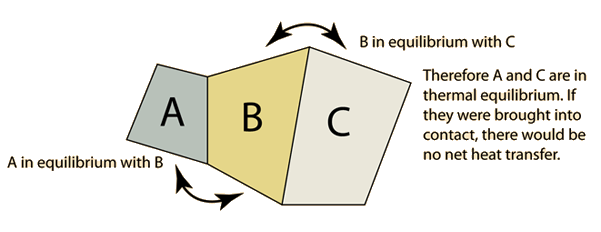Thermal equilibrium
Thermal equilibrium is the state of a system in which its heat flow is balanced with its surroundings, meaning the temperatures of the system and surroundings are the same. A system at a higher temperature will transfer heat to a system at a lower temperature when they are in contact, until their temperatures are equal.[1] Thermal equilibrium is an important concept for thermodynamics and blackbody radiation, and is the subject of the zeroth law of thermodynamics.
Thermal equilibrium is important for all heat transfer events, because it is what all systems will tend to over time. Knowing that interacting systems will tend towards the same temperature allows for important applications in all areas of science. For example, the specific heat capacity of a substance can be determined by placing it in water and measuring the temperature after a period of time.[2]

Equilibrium of the Earth
It is very important for the Earth to remain in equilibrium in order for its temperature to remain constant. The incoming solar energy to the Earth must be balanced, meaning the Earth must radiate just as much as heat it is receiving. The temperature of the Earth relies on the natural greenhouse effect in order to be habitable by humans and other animals, and without it the Earth would be far too cold. However the increase of carbon dioxide and methane in the atmosphere is increasing this greenhouse effect, causing slightly less heat to be let out of the Earth than is absorbed in Earth's energy flows. This slight imbalance from equilibrium is leading to a warming climate.
References
- ↑ Hyperphysics, Thermal equilbrium [Online], Available: http://hyperphysics.phy-astr.gsu.edu/hbase/thermo/thereq.html
- ↑ Hyperphysics, Calorimetry [Online], Available: http://hyperphysics.phy-astr.gsu.edu/hbase/thermo/calor.html#c1
- ↑ Hyperphysics, Zeroth Law of Thermodynamics [Online], Available: http://hyperphysics.phy-astr.gsu.edu/hbase/thermo/thereq.html#c2

